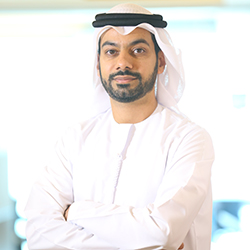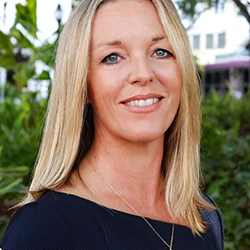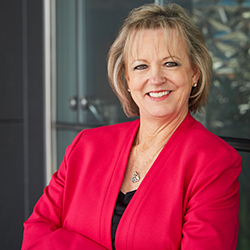
HIMSS22 speakers share their thoughts on reimagining health and ideas for improving the healthcare community.
- Atif Al Braiki, Abu Dhabi Health Data Services
- Cheong Ang, IBM
- Monica Bolbjerg, Qure4u
- Michelle Troseth, MissingLogic
Atif Al Braiki
Abu Dhabi Health Data Services, (Malaffi), Chief Executive Officer
HIMSS Future50 Health IT Leader, Class of 2021
 Technology is driving major changes in many aspects of healthcare, creating new expectations that the industry must strive to meet. Not only does it offer the potential for better patient experiences, but it gives us a wider opportunity to make meaningful enhancements to our social purpose and environmental sustainability obligations.
Technology is driving major changes in many aspects of healthcare, creating new expectations that the industry must strive to meet. Not only does it offer the potential for better patient experiences, but it gives us a wider opportunity to make meaningful enhancements to our social purpose and environmental sustainability obligations.
This includes the drive toward social equality and equal access to healthcare. The COVID-19 pandemic accelerated the rise of telehealth, with the market size expected to grow from $62.45 billion in 2020 to $475.50 billion by 2026. Combined with the growth of affordable wearable devices, technology introduces far better access to healthcare for those in developing countries.
However, these opportunities come with several important questions. How can governments develop a financially sustainable model for these innovations? Can the healthcare sector overcome the challenges that go beyond the technology – such as workforce/skills shortages? Who pays for these new services?
To answer the last question, arguably in healthcare it’s easier than in some other sectors to demonstrate purpose and shared beliefs. Technology can make health more equitable and can help to ensure resources are used appropriately and fairly.
Nevertheless, healthcare is complex, and any disruption will go beyond technology alone. Changing policy is key; we need to engage payers and providers, ensure policy makers are providing better access and better-quality care. Technological innovation is exciting, but we should keep in mind that it is just one element of a very complicated equation. There are lots of stakeholders involved and the economics of who is paying and how policies evolve is complex.
These are difficult equations to solve, but the power of data allows us to formulate evidence-based decisions to drive meaningful change. For example, using artificial intelligence (AI) to mine big data has several major beneficial impacts. It improves insights on population health data, especially when combined with the right health risk management platform.
Connected healthcare and improved interoperability also offer substantial cost containment benefits. This is a critical component of any innovation model, seeing as spending is growing amid the widespread move to integrated models of care. Digital transformation has a major role to play in this process – especially related to the over-consumption of healthcare.
In Abu Dhabi, Malaffi’s Health Information Exchange (HIE) covers one piece of this puzzle, with almost the entire sector now connected to a centralized database in less than three years. To witness how an HIE system takes on a life of its own by the limitless use cases on the level of the clinician, providers and the healthcare system is inspiring - along with how it unlocks opportunities for collaboration across the medical and pharmaceutical sector, to innovate drugs and provide new solutions.
But what else can we put in place to improve coordination between different systems? How can we better share data to both widen and improve resources further?
This is where digital can really improve healthcare. The healthcare workforce is over capacity and burdened by increasing costs. We must therefore look at what tasks can be automated and what administrative burdens can be reduced by technology.
The pandemic has demonstrated the power of data for making evidence-based decisions to manage public health and safety. The industry will increasingly work on solutions that improve our preparedness to tackle future challenges. Advanced AI analytics and aggregated data will allow the practice of personalised and value-based medicine, enabling more cost-efficient healthcare systems, improved access to care and healthier populations.
It’s an exciting future and will surely be a major talking point at HIMSS22. I look forward to joining those discussions.
HIMSS22 Sessions
Future of Healthcare: What’s Next and How do We Get There?
Reimagining Healthcare - Abu Dhabi’s Digital Transformation
HIE Interoperability – The Importance of Data Standardisation
Cheong Ang
Client Technical Leader, IBM
 It is exciting to be at HIMSS22. A big part of that excitement comes from the opportunity for the healthcare community to interact and have casual conversations that may lead to interesting ideas worth pursuing as well as collaborations.
It is exciting to be at HIMSS22. A big part of that excitement comes from the opportunity for the healthcare community to interact and have casual conversations that may lead to interesting ideas worth pursuing as well as collaborations.
Hence, I advocate for enabling frictionless, ongoing collaborations as my idea for “improving the healthcare community”, the first topic of the HIMSS22 Reimagining Health conversation.
While each of our organizations might have encouraged open discussions internally, we may benefit from more open forums that encourage members of the community at any level to discuss and collaborate on hot topics ranging from nursing shortage, appropriate use of AI, to simply staying afloat. We are rightfully more cautious when collaborating outside of our own organizations, but it helps to look at how others outside of healthcare leverage open forums to drive transformation at scale. For example, the blockchain/crypto world pioneered Decentralized Autonomous Organizations, the open-source community has been, for years, enabling collaborations in project-oriented GitHub setups, and students like my son, who is active in the Science Olympiad community, gain knowledge and skills through open forums in Discord.
There are open forums presented by the National Network of Public Health Institutes, and HIMSS-affiliated alliances and networks, among others. The key to broad participation is to establish a shared goal and remove hurdles. Encouraging active discussions and even work, especially around projects with tangible outcomes, and increasing access to such forums by simplifying requirements (e.g. organizational sponsorships, membership fees) may bring together many more of us who are enthusiastic about changemaking.
With increased collaboration, the second HIMSS22 topic of “reimagining health and wellness for everyone, everywhere” could simply be a culmination of the outcomes from groups that stand behind the projects, continuously working toward their respective North Stars.
On this second topic, I see the momentum of virtual care jumpstarted by the pandemic continue to push us forward, bringing opportunities to provide more asynchronous telehealth services. Even before the pandemic, we were concerned about being blind to a patient’s situation in-between visits, and believed we would have the opportunity to actually deliver health care, vs. sick care, were we to have the visibility and the ability to intervene remotely. Now patients’ adoption of telehealth, payers’ reimbursements for remote patient monitoring, and provider shortage are driving us toward investments into helping patients stay healthy.
For this shift, the hot investment areas will be in remote patient monitoring, using AI to better understand patients and to contextualize care actions, and scaling delightful, asynchronous patient engagement. The efforts will drive changes in processes as well as considerations such as healthcare equity and access. This is a journey toward a new era. The vision is not quite yet about delivering highly circumscribed care to a patient based on her “digital twin” in a metaverse environment via an avatar. But for sure, it is a journey toward a more financially sustainable healthcare system with an emphasis on personalized care with increased access and engagement.
HIMSS22 Session
Leverage Machine Learning for Staffing Optimization
Monica Bolbjerg, MD
Founder and CEO, Qure4u
 We need to rethink how we deliver care. For a very long time, provider insight into patient health factors was limited to brief encounters during relatively infrequent in-person visits. This limited interaction between patients and providers left gaps in care that contribute to poorer outcomes and higher costs. After experiencing this first-hand as a young physician, I set out to find a better way. Our mission at Qure4u is to bridge gaps in care delivery by enabling patient interaction between visits in a way that compliments provider workflows rather than disrupting them.
We need to rethink how we deliver care. For a very long time, provider insight into patient health factors was limited to brief encounters during relatively infrequent in-person visits. This limited interaction between patients and providers left gaps in care that contribute to poorer outcomes and higher costs. After experiencing this first-hand as a young physician, I set out to find a better way. Our mission at Qure4u is to bridge gaps in care delivery by enabling patient interaction between visits in a way that compliments provider workflows rather than disrupting them.
By offering patients self-service digital health tools before and after in-person visits, providers are reimagining care in a way that not only improves patient access, convenience, and experience, but also drives efficiency for their healthcare organization. Digital engagement solutions enable patients to facilitate routine administrative tasks that have traditionally been completed by the care team, such as appointment scheduling, form submission, and check-in. This frees up clinical staff for redeployment to higher priority responsibilities, which has been invaluable during the pandemic.
Digital engagement and communication between office visits through programs like remote patient monitoring also enhance provider visibility into patient health beyond annual in-person encounters. This enables earlier intervention and allows providers to stay in step with patients throughout their care journey. To support health equity, we recently partnered with AT&T, Samsung, and FirstNet to support RPM program connectivity in rural communities.
Over the course of the past two years, we’ve seen patient and provider trust in digital resources reach an important tipping point. As the frequency of digital engagement and integration continue to ramp up, patient data volumes will yield significantly greater insight into patient health variables. Our ability to identify actionable opportunities for intervention in that data will be crucial. Patient data captured through digital engagement and virtual care platforms must feed into provider EHR systems so that information can make it into the knowledge supply chain. The next frontier in digital health involves the real-time delivery of structured, actionable data to create opportunities for proactive clinical intervention. To meet this end, we’re working on technologies that can help surface pertinent data to clinical end users, ensuring that patient data makes the full journey from generation to application.
We are at such a promising phase in rethinking how we deliver care. Our providers deserve it, our care teams are depending on it, and our patients are craving it. The good news is the innovative technology — and patient and provider trust in it — now exists. I’m incredibly excited about what we’ll be able to achieve next.
HIMSS22 Session
Driving Health Through Patient Empowerment and Self-Service
Michelle Troseth, MSN, RN, FNAP, FAAN
Co-Founder, MissingLogic
 The healthcare community establishes a new standard of having leaders who are competent in Polarity Intelligence™ so they can recognize new ways to approach the same challenging, reoccurring problems that have been in healthcare for decades. The pandemic and the need to “recover” from the pandemic requires a new intelligence beyond problem-solving and traditional leadership tactics. It requires recognizing polarities and how to dynamically balance them. If we start with the leaders, it will improve their health and well-being personally and in turn improve their organizations and community.
The healthcare community establishes a new standard of having leaders who are competent in Polarity Intelligence™ so they can recognize new ways to approach the same challenging, reoccurring problems that have been in healthcare for decades. The pandemic and the need to “recover” from the pandemic requires a new intelligence beyond problem-solving and traditional leadership tactics. It requires recognizing polarities and how to dynamically balance them. If we start with the leaders, it will improve their health and well-being personally and in turn improve their organizations and community.
Healthcare leaders can begin by improving work-life balance for themselves and their teams in three different ways. The first way may seem counter intuitive, but it is for leaders to be committed to work-life balance themselves and be role-models for their teams. Think of the familiar saying, “Do as I say, not as I do”. Whether healthcare leaders know it or not, they are being watched all the time. If leaders role model work-life balance, the chances of their teams improving work-life balance is very favorable.
The second way leaders can improve work-life balance for their teams is to encourage boundary setting. While many are being asked to go the extra mile, team members also need to be reminded to be aware of early warnings that they are giving too much to work. Work and home are interdependent and if there is too much focus on work at the expense of their home life, work-life balance will not be attained, and burnout is 100% predictable.
The third way leaders can improve work-life balance for their teams is to provide the time and space for them to reflect and learn together. We have consistently seen the benefit of teams coming together to share their struggles and lean into each other for support. Guided learning with coaching has been the best way to assure their teams are supported and learning new skills and competencies to improve their work-life balance.
Everyone, everywhere is 100 percent responsible for their health and well-being and they have the tools, processes, and resources to be healthy and well every day. No one works from circumstances. People have often seen what is happening to them as the cause of their dissatisfaction and they fall into being a victim. The more the focus is on circumstances, the more those circumstances are experienced and soon people begin to feel stuck. To shift out of working from circumstances or a victim orientation, the attention of the leader and team members must shift to be more internally focused. This shift in attention can move them into a creator orientation and gain health and wellness for everyone, everywhere.
Healthcare leaders and their teams are the ones that lead the way by creating and role-modeling thriving, balanced and resilient lives, so they can make a difference and enjoy life enabling them to live with intention, experience more joy and be their best self at work and at home. In turn, they impact everyone, everywhere in their community.
HIMSS22 Session
Reimagining What it Means to be Well and Thrive
Reimagine Health: HIMSS Global Health Conference
March 14-18, 2022
Join changemakers at HIMSS22—in person and digitally—as we reimagine health together through education, innovation and collaboration.



